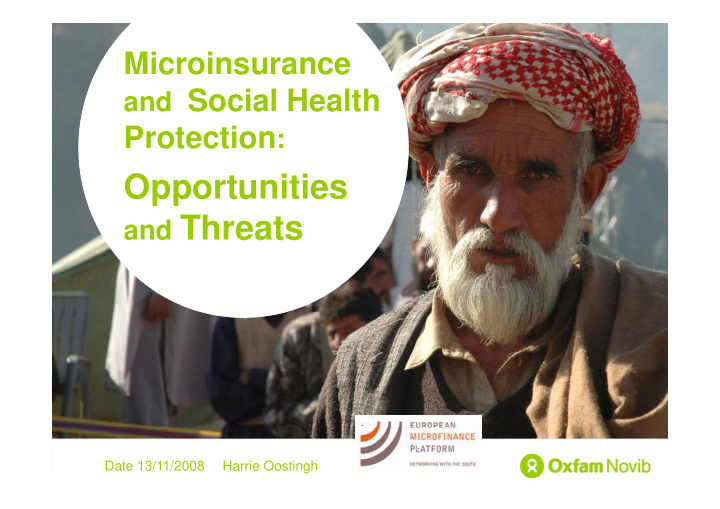



Microinsurance and Social Health Protection : Protection : Opportunities Opportunities and Threats Date 13/11/2008 Harrie Oostingh
Rationale for Health Micro Insurance • 5.6 billion people are unprotected against consequences of illness (50% of THE from OOP) (WHO, 2008) ( % ) ( , ) • 100 million people annually fall into poverty because they have to pay for care (Xu K et al 2007) have to pay for care (Xu K. et al 2007). • Insurance schemes provide a stable income for service providers and facilitate investments in quality of care (IFC, 2008). • Poor people priorize health, when asked about risks they’re concerced about (Cohen, Sebstad, 2006) 2
What risks are people concerned about? Craig Churchill,(2007) adapted from Cohen and Sebstad (2006) Country Priority Risk Uganda U d Ill Illness, death, disability, property loss, risk of loan d th di bilit t l i k f l Milawi Death, food insecurity, illness, education Philippines Philippines Death old age illness Death, old age, illness Vietnam Illness, natural disaster, illness, livestock disease Indonesia Indonesia Illness children’s education poor harvest Illness, children s education, poor harvest Lao P.D.R. Illness, livestock disease, death Georgia Georgia Illness, business loans, theft, death, retirement income ess, bus ess oa s, t e t, deat , et e e t co e Ukraine Illness, disability, theft Bolivia Illness, death, property loss (incl. Crop loss in rural areas) y ( ) 3
Growth of Health Microinsurance • ’80s: Community Based Health Insurance Schemes in response to user fees to user fees • Extension of Social Protection through Microinsurance – 2003: ILO Campaign on Social Protection (STEP) • Development of insurance markets Development of insurance markets – 2006/7: Dutch Gvmt 125 mln € in Private insurance • World wide 35 million people covered through health microinsurance (Landscape study 2007) 4
Insurance as alternative for failing public bli f ili f ti lt health care 5 I
What should social protection do? • To ensure that all individuals have access to health care (access) (access) • Reducing or eliminating the possibility that an individual will be unable to pay for such care, or will be impoverished as a result of trying to do so (financial protection). • Funding and set financial incentives for providers (strategic purchasing) • Fair distribution of costs (equity) 6
What can Microinsurance do? (Criel, Ekman, Drechsler, Jütting, Dror) Access : – Enrolment is relatively low : average 25% (0.3 – 90.3%) Enrolment is relatively low : average 25% (0 3 90 3%) – Income and distance to care are main obstacles – Members seek care more frequently and earlier (PHC) – Micro Health Insurance as entry point to public schemes Financial protection Financial protection – (=prepaid/OOP) varies between: 11-60% – Prepayment ratio (=prepaid/ total cost) small. p y ( p p ) – Catastrophic expenditure dropped from 35.6 to 15.1% (SEWA) 7
What can Microinsurance do? (II) Strategic purchasing: – – Divers results; low in case of CBHI better in case of larger Divers results; low in case of CBHI, better in case of larger schemes – Supply constraint Equity – Fragmentation risk pools with low solidarity Fragmentation risk pools with low solidarity – Insurance market failure: tendency to exclude precisely those people who need it most (HIV, age) – Poorest don’t have access Poorest don t have access – Two examples: ILO inventory of 14 HMI India, 2005, CARE developing health insurance for PLWHA. 8
Why policy makers are hesitant: Wh li k h it t Constraints from a systems perspective • Efficiency of premium based financing in informal markets (administrative costs between 15-85%) • Regulating insurance schemes is complicated: transaction cost for implementing regulation can represent up to 30% cost for implementing regulation can represent up to 30% of premium revenue (Kumaranayake, Lilani, 1998) • Health care should focus on prevention. PHC has potential to prevent 70% of disease burden (WHO, 2008) • Insurable interests do not always represent high OOP (Research Dror) 9
Innovation: the case of Ghana • Initial network of CBHI (2002 47 schemes <10% coverage) • NHIS 2003 launch • Minimum Benefit Package (gov 95% burden disease) • Financing: premiums + taxes (VAT+2,5%) + transfer SHI (2.5% contributions) • Contracting services: 49% public, 51% private Results: coverage 10% in 2003 - >70% 2008 Results: financing 75% tax 24% SHI 1% premium Results: financing 75% tax, 24% SHI, 1% premium 10
CONCLUSIONS • Potential of microinsurance as a mechanism for social health protection is modest (constraints on social health protection is modest. (constraints on comprehensive coverage, equity, efficiency,) • MHI has positive impact on reducing OOP and catastrophic health expenditure for people able p p p p to join. • Not mechanism to increase availability of resources, but to increase efficiency of their use 11
CONCLUSIONS • Microinsurance: pooling financial resources and / or raising social capital or raising social capital – Organisation of informal economy – Channel of subsidies – Empowerment towards providers • Strengthening accountability of health systems g g y y 12
Recommend
More recommend